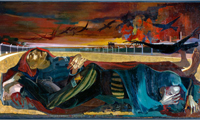
Art in Two Germanys Often Spoke the Same Tongue
By MICHAEL KIMMELMAN
Published: February 11, 2009
BERLIN — East German art, like much of what used to be East Germany itself, hasn’t fared altogether well here since the Wall fell. Twenty years on, victorious Westerners, at least those old enough to remember the country divided, still tend to look with contempt on what passed for culture under Communism, as if the two, culture and Communism, were mutually exclusive. A curious hint of revenge sometimes creeps into their voices.
Call it communal myopia. A recent article in Die Zeit, a German newsweekly, lamented how the new Moritzburg Museum in Halle shortchanges its own collection of East German paintings, one of the best in the country, “in a way that is almost shameful.” The article wondered whether the curators there weren’t maybe being a little parochial and spiteful, and afraid “to revise overly quick judgments made in the years after the reunification of Germany.” That meant above all the verdict that East German art, like the whole Communist era, would be best forgotten.
▶ 자세한 내용은 원본링크를 따라가세요.
 Art in Two Germanys Often Spoke the Same Tongue
Art in Two Germanys Often Spoke the Same Tongue